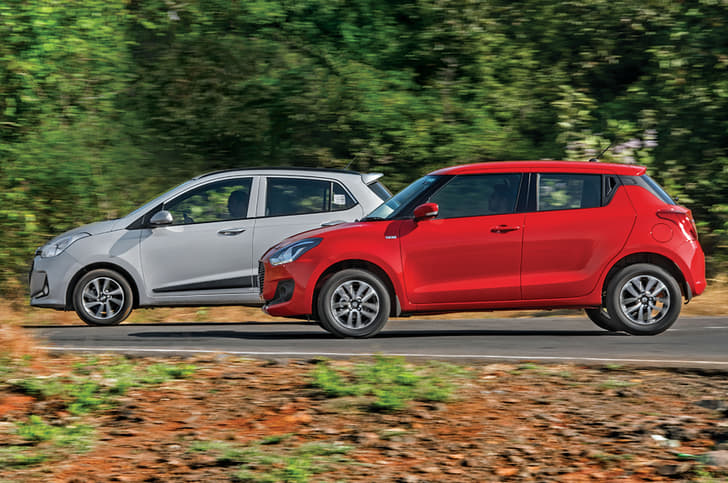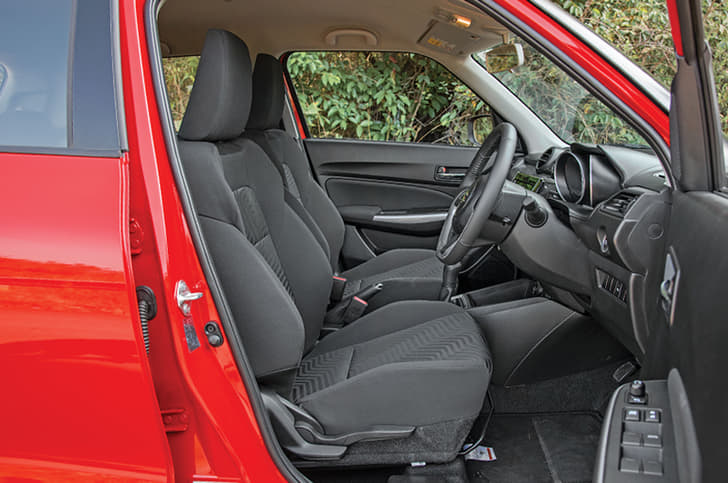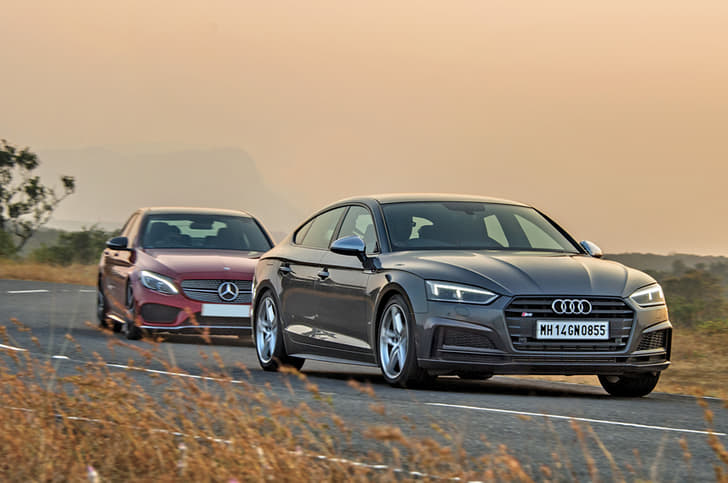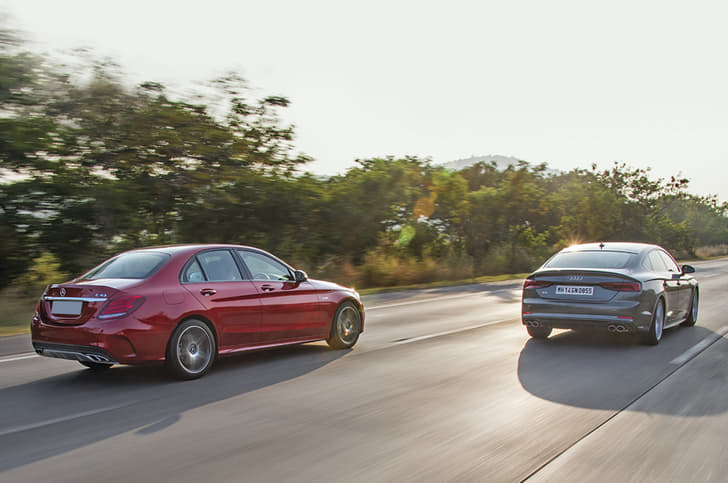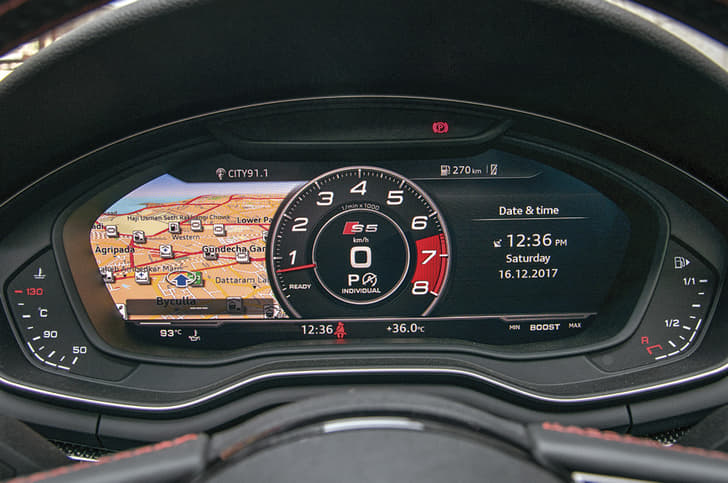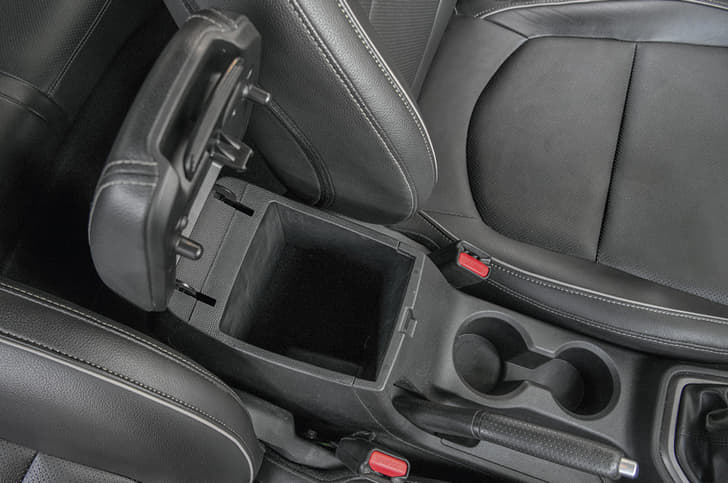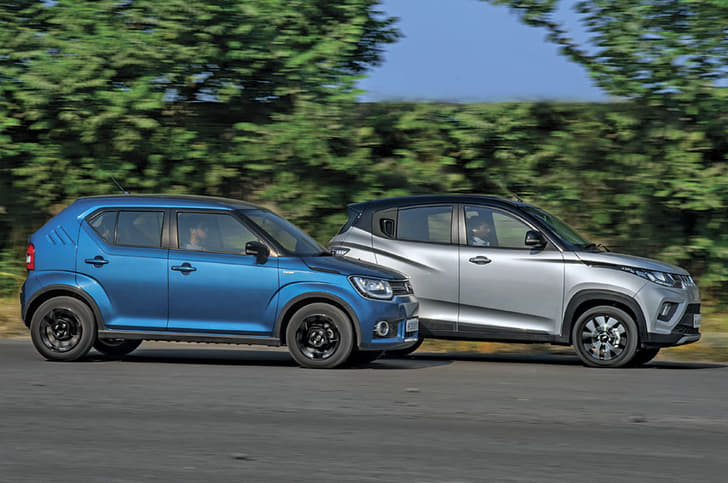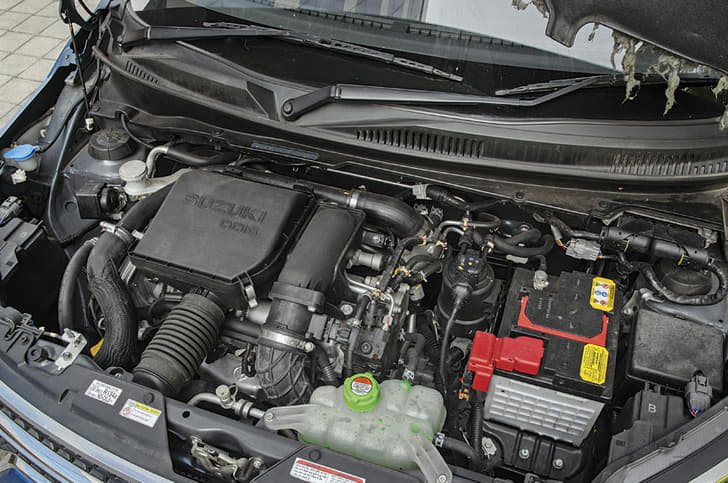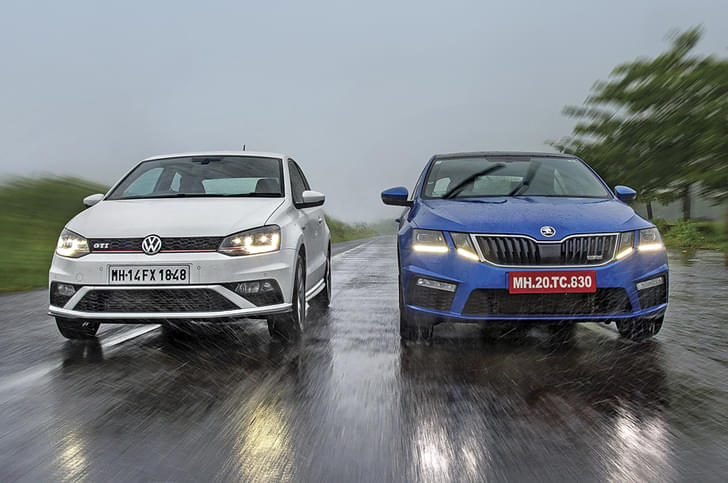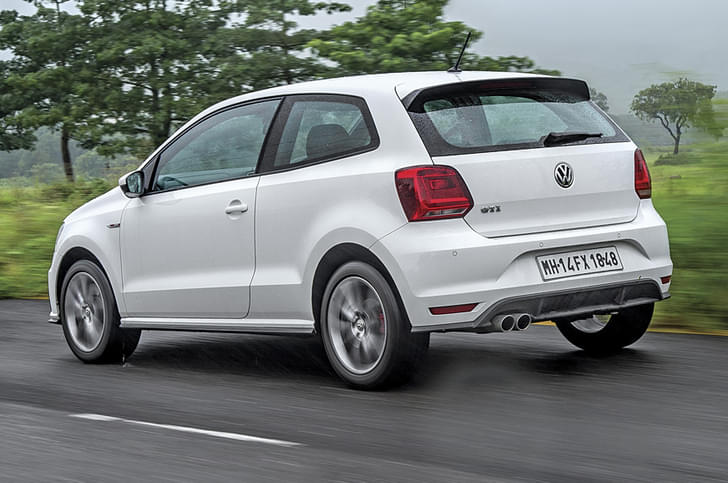The Maruti Suzuki Swift has been the segment-defining hatchback ever since its launch. A sporty character, youthful persona and frugal engines, really helped build the Swift brand, and as a result, this car managed to reach 1.7 million households across the country. Even now, its sales have remained relatively unfazed despite rising competition. It's only the Hyundai Grand i10 that's managed to make an impression on the segment buyers with its upmarket quality, premium kit and easy-to-drive nature. It’s a very competent car and with its new 1.2-litre diesel engine, added features and improved dynamics, it's become even more attractive now.
So, is the third-generation Swift really a better package when compared to the well-rounded Hyundai Grand i10? We put both under the scanner.
| Dimensions | ||
|---|---|---|
| Maruti Suzuki Swift | Hyundai Grand i10 | |
| Length | 3840mm | 3765mm |
| Width | 1735mm | 1660mm |
| Height | 1530mm | 1520mm |
| Wheelbase | 2450mm | 2425mm |
| Boot space | 268 litres | 254 litres |
| Turning circle | 9.6m | 9.6m |
What are they like inside?
The new Swift’s all-black interiors and dashboard design are quite refreshing. Bits like the flat-bottomed steering wheel, round air-con vents and climate control console with an attractive LCD monotone display, all add a premium touch to the cabin. Even the speedo and tachometer dials with red highlights are very sporty. There aren’t any soft-touch materials to speak of and all the plastics are still a bit hard, but quality is much nicer now though some bits and switches are still carried over from the older car. The new superbly contoured front seats provide great support to front occupants and hold them in place while cornering. Cushioning is a bit soft though, and that means the seats are unlikely to be as comfortable as earlier on long drives. The biggest surprise, though, is at the rear and it’s mainly good news. There’s a lot more interior room than the outgoing car so head, knee and legroom are vastly improved. Crucially, it’s noticeably larger than the Hyundai here. However, the back seat is a bit upright, in comparison, and because the rear door handle is mounted beside the C-pillar, passengers can feel a bit claustrophobic. The super-light build of the new Swift is also disappointing as well. What’s good though is that the boot is now larger and manages to hold more than the Grand i10's.
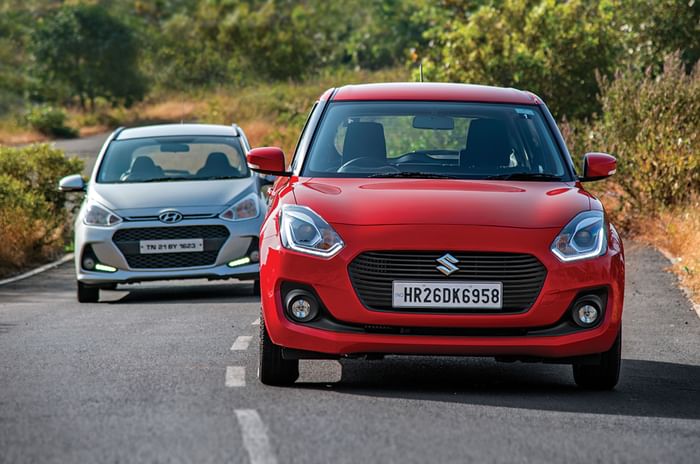
The beige and black theme of the Hyundai’s interiors play a big role in brightening up the cabin and lending it a premium look. While the design is functional rather than sporty, the quality of plastics feel a bit better and more consistent when compared to the Swift, and the build of the Hyundai is also clearly tougher. The front seats, however, are narrower in comparison to the Swift’s and the headrests can’t be adjusted for taller drivers; a big risk for taller drivers who are exposed to whiplash risk due to an impact from the rear. Shorter drivers will complain of a longer seat squab too. The back seat is comfier due to the nice backrest angle. Leg and knee room are lesser than the Swift’s however, and fitting a third rear-seat passenger is a squeeze because the cabin is substantially narrower.
| Equipment | ||
|---|---|---|
| Maruti Suzuki Swift | Hyundai Grand i10 | |
| Auto headlamps | LED | No |
| Projector headlamps | Yes | No |
| Electric mirrors | Yes | Yes |
| Reverse camera | Yes | Yes |
| Climate control | Yes | Yes |
| Touchscreen infotainment | Yes | Yes |
| Alloy wheels | 15-inch | 14-inch |
| Rear AC vents | No | Yes |
| Keyless entry/go | Yes | Yes |
Equipment and safety
Not too long ago, it was Hyundais that offered the maximum number of cool features for your money. Now the times are changing for Maruti as well and there are now several segment-first features like automatic projector LED headlamps with daytime running lamps, part-LED tail-lamps. Other features offered on the top-spec versions of both cars include electric folding mirrors, automatic climate control, rear wiper/defogger, keyless entry and an engine start-stop button. While both cars get a touchscreen infotainment system with Android Auto, Apple CarPlay and navigation, it is the Hyundai’s that is slicker and much nicer to use. The only feature exclusive to the Grand i10 is the rear air-con vents.
In terms of safety, the top variants of both cars get ABS and dual airbags, however, Maruti offers these as standard right from the base variant of the Swift; a big thumbs up. Then, all variants of the Grand i10 get slender 165/65 R14 wheels. Low variants of the Swift get 165/80 R14 tyres, whereas the top variants get 185/65 R15 tyres.
What are they like to drive?
This third-gen Swift may be new, but the Fiat-sourced 75hp, 1,248cc, four-cylinder diesel engine is the same. What’s impressive is that this time around there is no engine noise inside the cabin, especially at low speeds. There’s still a significant amount of delay before the turbo starts spinning faster and boosts power, so at low revs (below 2000rpm) the Swift is slow to pick up speed. As a result, in the city, there is a need for constant gearshifts to keep the engine on the boil. The gearbox, however, is a delight to use with its short and precise throws and a light clutch, and once the diesel has crossed 2,000rpm, there’s enough punchy performance on offer. Out on the open road, as long as you keep the engine in the meat of its powerband, overtaking is quite easy and it pulls strongly all the way until 5,200rpm in a free manner. It does get loud as the revs build, but the light weight of this new car and the wide powerband allow for plenty of enjoyable performance.
The Hyundai Grand i10 gets a 1,186cc, three-cylinder diesel that makes the same power as the Swift. This engine though is a bit louder and more clattery at low and mid engine speeds; contrary to what we’ve come to expect from modern Hyundais. Performance is a bit more effortless initially, compared to the new Swift, and is available even before 2,000rpm. This is the easier car to drive in start/stop traffic. It doesn’t warrant downshifting to lower gears as often, and unlike the Swift, there’s no spike in performance at mid revs, so power delivery is smooth and strong. This engine isn’t very happy to spin hard and it runs out of breath after 3,500rpm, which means the Hyundai is not as involving to drive in a more energetic manner.
This is borne out when you look at numbers. The Swift goes from 0-100kph in just 13.67sec, which is 1.4sec faster than the Grand i10, and even in-gear, the Swift is much faster in the 40-100kph dash by 2.35sec. However, in real-world city driving conditions, it’s the Hyundai that’s better for quick overtakes within third gear; the Grand i10 accelerates from 20-50kph 0.75sec faster than the Swift, which is quite significant.
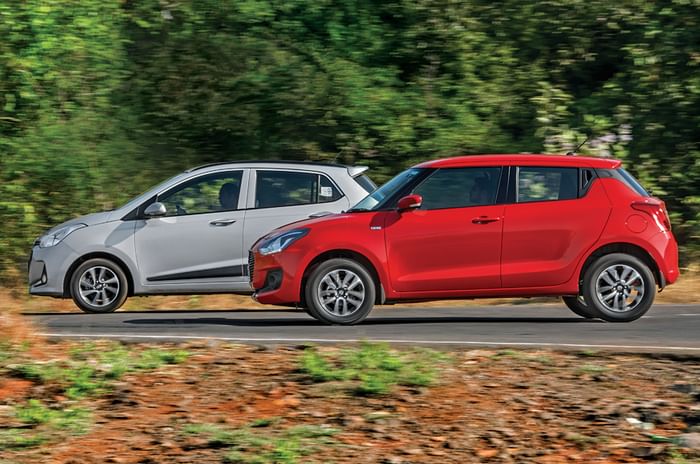
One of the USPs of the Swift has been its fun-to-drive nature. But giving in to user demand, Maruti has now made the power steering really light to make it effortless to twirl in traffic and change lanes. This, however, means that the feel and feedback that owners loved so much in the earlier car is missing. Its suspension is now a lot nicer with a very absorbent ride. It rounds up rough sections really well, and although there is a bit of stiffness at low speeds, the ride remains flat and composed once you go faster. Then there’s the handling which isn’t as go-kart-like as before; so those looking for an even sportier drive will be disappointed. However, it’s still fairly sporty to drive and will please keen drivers on winding sections of the road. The lack of feedback from the steering is a disappointment, but the steering is quick and accurate and the car has a nice sense of balance in corners. There’s a fair amount of grip and the Swift likes going from one corner to the next.
The steering on the Grand i10 is heavier in comparison but weighs up inconsistently. It’s still light enough to use in the city, but the Swift’s is a bit lighter. Hyundai has maintained a fine balance between ride and handling. Bump absorption is better than before, but it still crashes over the odd sharp bumps and doesn’t feel as planted as the Swift at highway speeds either. This car isn’t as agile around corners either, and though it turns into corners quite confidently, the narrower 165mm wide tyres do tend to struggle for grip. The Grand i10’s brakes have the sharper initial bite, but it’s the Swift’s that feel more reassuring and a lot easier to modulate.
| Powertrain and performance | ||
|---|---|---|
| Maruti Suzuki Swift | Hyundai Grand i10 | |
| Fuel | Diesel | Diesel |
| Engine | 1248cc, 4 cyls | 1186cc, 3 cyls |
| Power | 75hp at 4000rpm | 75hp at 4000rpm |
| Torque | 190Nm at 2000rpm | 190Nm at 1750-2250rpm |
| 0-100kph | 13.67s | 15.10s |
| Top speed | NA | 150kph |
| 50-80kph through the gears | 4.79s | 4.05s |
| 20-80kph (third gear) | 11.94s | 11.60s |
| 40-100kph (fourth gear) | 15.26s | 13.75s |
| Braking 80-0kph | NA | 30.22m |
| Claimed economy | 28.4kpl | 24.95kpl |
| Tank size | 37 litres | 43 litres |
| Range | 1051km | 1073km |
Buying and owning
Maruti has launched the Swift in 12 versions including automatics (AMT) with both engine options.
The model tested is the range-topping ZDi+ that is frankly pricey by class standards at Rs 8.29 lakh (ex-showroom, Delhi). If you are open to forgoing some goodies like the LED headlights, the touchscreen infotainment system and diamond cut alloy wheels, you can have the more sensibly-priced ZDi that comes in at Rs 7.49 lakh. The Swift gets the same two-year or 40,000km standard warranty like other Marutis, and buyers also have the option to extend it up to the fourth year or 80,000km at an additional cost.
The Grand i10 too is available in 12 variants including the petrol automatic option. We tested the top Asta variant that’s priced at Rs 7.37 lakh (ex-showroom, Delhi). Hyundai offers a two-year standard warranty too, but with no restrictions on the mileage of the car. There’s also an extended warranty available for up to the fourth year or 1,00,000km for Rs 9,910, an option that’s highly recommended.
Which one should you buy?
The Hyundai Grand i10 offers almost everything that buyers are looking for. The interiors have an upmarket feel, the equipment includes kit like a touchscreen, and with light controls, this is a car that's very easy to drive. However, the diesel engine isn’t as smooth as that of the Swift. Still, you get a decent-sized boot, adequate space for four passengers and the car is well equipped too. Seen in isolation, there’s really little to fault in this Hyundai.
Maruti, however, has taken the game up a few notches with this new Swift. Sure, those looking for a sportier drive than the older generation might be a bit disappointed and the engine is carried over from 2010, but the car is still fast and fun. The new car is a lot more spacious and more practical now with a larger boot. Then, the interiors ooze a sporty character and while the quality of bits might not be segment-best, there are several parts like the air-con vents, flat-bottomed steering and sporty dials that look great. The diesel engine is the quieter of the two and although it might not be as easy to drive because of the delayed power delivery, it gets the stronger engine. Even on the highway, the car rides nicely and remains flat and composed. And finally, the equipment list is really long and betters the Grand i10. The Swift is undoubtedly expensive in top-spec form but it is also easily the better car here. Maruti has another blockbuster on its hands.

